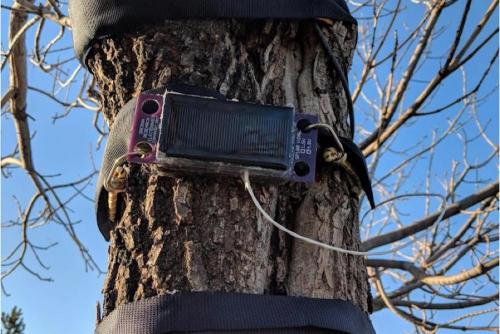https://newatlas.com/science/a...
Strapped-on accelerometers used to monitor tree activity
By Ben Coxworth
May 05, 2022

Amongst other things, monitoring the growth cycles of trees could help show how they're being affected by environmental factors such as climate changeDeidre Jaeger/CIRES
Looking at big, mature trees, you may not think that their trunks sway much in the wind. They do to a certain extent, however … enough so that electronic measurement of the swaying motion can be used to monitor their growth cycles.
Although trees sway in the breeze all year round, the manner in which they do so varies depending on how much water is present in their trunk, branches and leaves.
In the spring and summer, for instance – when a tree draws in water as it produces leaves, flowers and/or fruit – it's particularly flexible, plus its mass is increased. Therefore, its sway period is longer than when it's dry, brittle and leafless in the winter. The term "sway period" refers to the amount of time that it takes for the trunk to sway from one side to the other.
In order to explore the possible applications of sway measurement, a team from the University of Colorado at Boulder strapped accelerometers onto two white ash trees on the university campus in 2018. Over the following years, it was found that the trees' swaying motion not only corresponded to their periods of growth and dormancy, but it could also be used to determine when they were blossoming and releasing pollen.
"The development of the flower buds coincides with increased mass as the tree is pulling up more water – with the mass change, the sway period is longer," lead scientist Deidre Jaeger told us. "In my study I found that the sway period dropped with the opening of flowers and the release of pollen, before the sway period increased with the budburst of leaves that follow flowers in ash trees."
It is now hoped that the use of accelerometers could serve as a more practical alternative to other methods of remotely monitoring tree growth – particularly within cities. Analyzing satellite images of trees, for example, can be difficult if you're trying to monitor a single species which is mixed in with others. And time-lapse cameras can be expensive, plus they raise privacy concerns when used in urban settings.
"Accelerometers are discrete, continuous and unaffected by the action or physical barriers a city environment presents," said Jaeger. "We get high-res, reliable data."
A paper on the research was recently published in the journal Agricultural and Forest Meteorology.
Source: University of Colorado at Boulder
